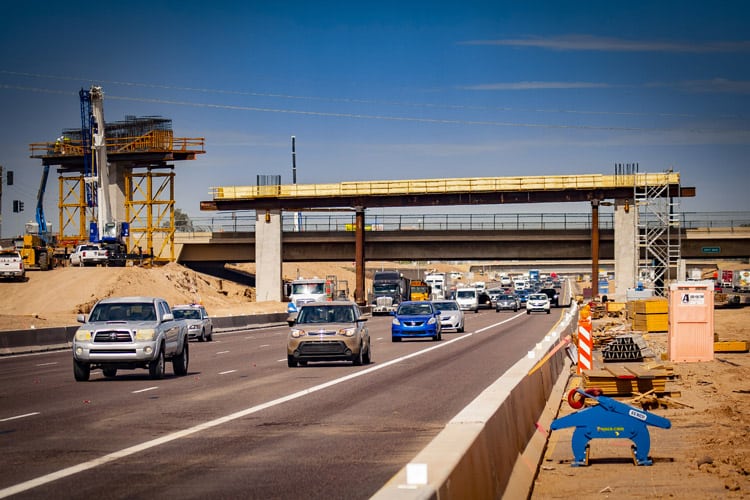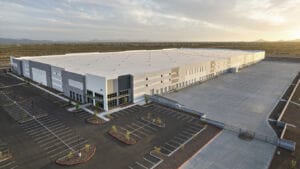It’s not often when 22 miles of freeway is added to a major city in the U.S. It also isn’t often when a large area becomes ripe for a slew of economic development opportunities for a variety of markets.
Phoenix is set to see all of this become a reality when the South Mountain Freeway is finished in late 2019.
This brand-new stretch of freeway will serve as the connector between the East and West Valley and will not only add value to the existing southwest industrial submarket in Phoenix, but it will also pave the way for business parks, retail and housing developments.
The 22-mile extension of the Loop 202 will run East to West along Pecos Road stemming from the Interstate 10 and Santan Freeway south of Chandler Road. The Loop 202 will then stretch around South Mountain, cutting north and south between 55th and 63rd avenues on the way to the Interstate 10 at 59th Avenue in the West Valley.
Where the $1.7 billion South Mountain Freeway will go is, “projected to have some of the greatest growth in the Valley,” says Dustin Krugel, a public information officer at the Arizona Department of Transportation.
Krugel says the South Mountain Freeway is going save many Valley motorists time on their commutes, particularly folks who are traveling between the East and West Valley. Upon completion of the freeway, drivers can bypass downtown Phoenix.
Someone departing from the southeast part of the Valley, headed west, will be able to save about 25 minutes both ways in their commute, Krugel says.
Shovels at the ready
Land values along the South Mountain Freeway corridor have risen “substantially” since construction started and a timeline for completion was laid out, says Greg Vogel, founder and CEO of Land Advisors Organization.
Prices for residential plots in the Laveen area rose, and Vogel has seen developers begin plans for a new wave of multifamily projects in the Estrella Village area – something that hasn’t occurred in a while, he adds.
“There are well over a dozen parcels of land that are in some form of plating or planning, or in flow of a transaction as we speak,” Vogel says about the activity in the Laveen area.
The South Mountain Freeway is set to impact many commuters and residents across the Valley, and it will also smooth out the movement of trucks from the industrial areas.
While land rises for future residential projects, Vogel says that industrial land values in this area have been stable for the past five years.
Industrial parcels within this submarket, especially areas along Broadway and Lower Buckeye roads will still receive a benefit with easier access to the Interstate 10 for trucks and commerce, Vogel says.
“The idea that you’ll have proximity to that freeway, I think will be quite helpful,” he says.
Joe Trinkle, senior vice president, regional director – South and West Region for Liberty Property Trust, says industrial jobs north of Broadway Road will grow. There’s already a land constraint in that area, but many industrial land acquisitions occurred in the last 18 months, he adds.
Liberty Property Trust owns over 2.3 million square feet of industrial facilities within a five-mile radius of where the Loop 202 will meet the Interstate 10 at 59th Avenue, Trinkle says. The 2.3 million square feet of industrial space includes the 1.4 million-square-foot Liberty Logistics Center II at 71st Avenue and Buckeye Road.
That parcel has an additional 20 acres for development available still, Trinkle says. And in the past 24 months, his firm added about one million square feet to the southwest industrial submarket, he explains.
Liberty Property Trust is also actively looking for development opportunities in that sub-market near the Loop 202 extension, he adds.
Ease of access
The addition of the South Mountain Freeway is going to continue the maturation of the West Valley as it makes travelling across the Valley much easier.
Trinkle believes more residential development is going to happen across the West Valley thanks to the addition of this freeway.
Specifically, residential development south of Broadway Road in the upcoming South Mountain Freeway corridor will receive additional development, Trinkle said.
“There’s more people wanting to live in the West Valley, because now they’re going to be able to commute to work on the 202 down to the East Valley much more quickly and much more easily than they can today,” he says.
With more residents in the area, there will be even more demand for other assets. Developers are planning to deliver too.
Kitchell is currently in the works of developing a multi-phase, mixed-use development on 170 acres near Baseline Road and the South Mountain Freeway. The first phase of this project will focus on retail and Kitchell plans to make more announcements about this project in October.
“In the last 18 months, we’ve definitely seen more developers trying to establish land positions in the corridor in preparation for the completion of the 202 at the end of 2019,” says Trinkle.
Tapping into talent and Phoenix’s big plans
WESTMARC recently did a comprehensive report on the population of the West Valley. Az Business magazine reported WESTMARC’s findings in July, that highlighted the incredible amounts of talented workers residing in the West Valley.
WESTMARC noted that 40 percent of Phoenix’s 1.5 million residents live west of interstate 17 and 1.6 million people live in the West Valley all together. Of those living in the West Valley, 69 percent of the workforce commute to other regions in Maricopa County.
According to WESTMARC, 37 percent of healthcare workers living in Maricopa County live in the West Valley, while 21 percent of the healthcare jobs are in the region.
Meanwhile, 28 percent of manufacturing workers in the county live in the West Valley, with only 16 percent of those jobs located in the West Valley. And, 34 percent of the professional finance and insurance workers in Maricopa County call the West Valley home while only 12 percent of their jobs are located in the region.
The Loop 202 South Mountain Freeway will not only make the lives easier for those who are commuting from West to East, but the freeway will facilitate the creation of future jobs that are much closer for those workers.
“Around the Broadway Road area, is really where we see so much opportunity from an economic development standpoint to diversify the West Valley economy,” says Lori Collins, deputy director of the City of Phoenix Community and Economic Development Department.
By looking at the WESTMARC workforce data, Phoenix believes that a mix of the existing workforce residing in the West Valley, the new freeway accessibility and the right commercial real estate development along the corridor could create fresh opportunities for quality job growth, Collins says.
Phoenix envisions insurance, healthcare, technology and advanced manufacturing companies creating jobs within this corridor, she says.
“That’s where we think there’s a great opportunity to capture some really talented people closer to where they live,” Collins says.
And with that extra job growth, housing and amenities would support that growth too, she adds.
This planned area by the city will be known as the South Mountain Technology Corridor. Phoenix wishes to see the development of modern business parks that would be able to house both technology and advanced manufacturing companies, Collins says.
“(The Loop 202 extension) allows us to create a new employment corridor. So, I think that helps to diversify the West Valley area where it’s not just going to be residential, and it’s not just going to be warehouse and distribution,” Collins says. “(The freeway) is a chance to create a brand-new employment corridor. It’s something you don’t run into very often as an economic developer.”




